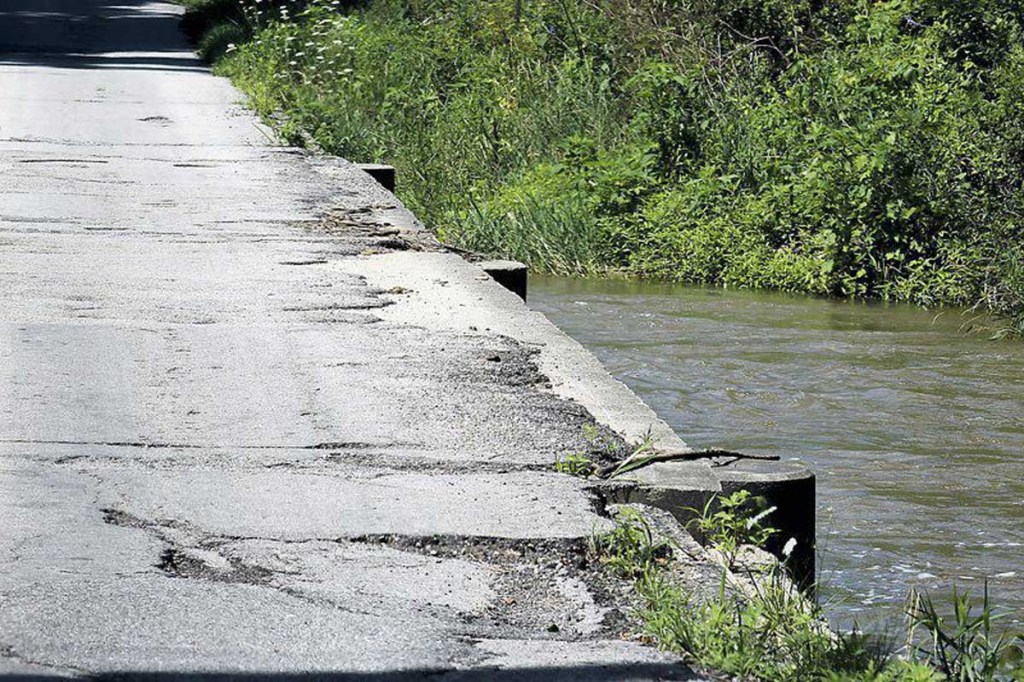Poor roads, bridges make work harder for Indiana farmers
Published 10:30 am Thursday, July 27, 2017

- A Shelby County bridge that Ramsey crosses daily hasn't received a facelift in 30 years. With no railings and uneven surfaces, the bridge leaves potential for accidents wide open.
Farmers in Indiana are facing a series of roadblocks — both literally and figuratively — when it comes to the use of the local infrastructure to get things done. In fact, the worn rural byways and bridges have farm workers stuck between a road and a hard place when it comes to their business and potential tax increases.
For Phil Ramsey, there are two ways he can reach his fields when driving a harvesting machine — cross a bad bridge, or cross one that’s even worse.
Trending
“One is really narrow and overgrown with trees, and the other is a flat bridge that’s really narrow and low,” Ramsey said. “And we have to go across it with wide equipment.”
The Shelby County, Indiana, farmer has dealt with deteriorating rural roads and bridges for years. But as modern farming equipment gets bigger and heavier, he’s worried about what could happen.
“If we slipped off the bridge I would tear up a bunch of equipment, and I’ll be really ticked off because I need that equipment,” Ramsey said. “It’d be a big financial loss.”
Ramsey and other Hoosier farmers hope that such concerns are addressed in the Next Level Indiana plan, which was announced in July, to repair state roads and bridges over the next five years.
Nationally, infrastructure issues plague a number of urban and rural community roadways and bridges. Earlier this year, a report from the American Road and Transportation Builders Association cited more than 55,710 bridges that needed repairing or replacing. The report also named states like Iowa, Pennsylvania, Oklahoma and Missouri as states with bridges in the worst condition.
Back in Indiana, about $4.7 billion will be spent on the improvement efforts. The money comes from Indiana’s state road-funding plan that went into affect July 1. The plan included a 10-cent per-gallon gasoline tax hike and increased vehicle registration fees.
Justin Schneider, Indiana Farm Bureau director of state government relations, said that even though no one wants their taxes to go up, it’s crucial that farmers in rural areas have easier access to safe roads and bridges.
“It has really become a concern for people, and there’s a realization that we’ve got to do something,” Schneider said. “We have to come up with a long-term fix.”
Crossing a fine line
“Our combines are as wide as that bridge is,” Ramsey said, pointing to a deteriorating structure near his home. “The pavement doesn’t go all the way out to the cement. So when you’re driving across it, your rear tires are bouncing on the edge, back and forth.”
The uneven slab of concrete is so low that when heavy rains come, the entire bridge is submerged, Ramsey added. It hasn’t had repairs, he said, in almost 30 years.
“I talk to the commissioners all the time about these bridges, and I get the same story: ‘We don’t have any money, we don’t get much,’” he said. “Even though I’ve been complaining about it, I cringe at the thought that they would close it.”
If that happened, Ramsey would have to find an even longer route to take.
“Many times, that means traveling a great deal of distance extra or out of the way to get to their field,” said Kendell Culp, Indiana Farm Bureau vice president. “In some cases, they can travel 10 miles out of their way just to try and navigate around a bridge or obstacle.”
Culp, a farmer and Jasper County commissioner, knows all too well the difficulties farmers face when roads or bridges are inadequate. After Ramsey showed him a picture of his combine crossing the bridge, Culp was shocked.
“I said, ‘That looks dangerous.’ And he said, ‘Well, the other bridge has sides on it, so I can’t get my tractor or combine down it because it’s too narrow,’” Culp recalled. “So in that county, they’re sacrificing safety to accommodate wide loads. And that’s not a good place to be.”
Although the Indiana Farm Bureau is fiscally conservative, Schneider said the majority of its members were in support of Gov. Eric Holcomb’s road-funding plan because of roadway challenges they’ve encountered for decades.
“By improving our infrastructure and transportation system, you’re going to find farmers will generally be supportive of that,” Culp said.
Shelby County received roughly $29 million for repairs in the next five years, but neither of Ramsey’s bridges are on its project list. After five years, an additional $342 million will be available for statewide local road projects through 2024.
But Ramsey doubts that money will wind up in his area.
“I’ll hold my breath for that one,” he muttered. “We’re not in an area of high priority.”
Stancombe writes for CNHI’s Indiana Media Group.



